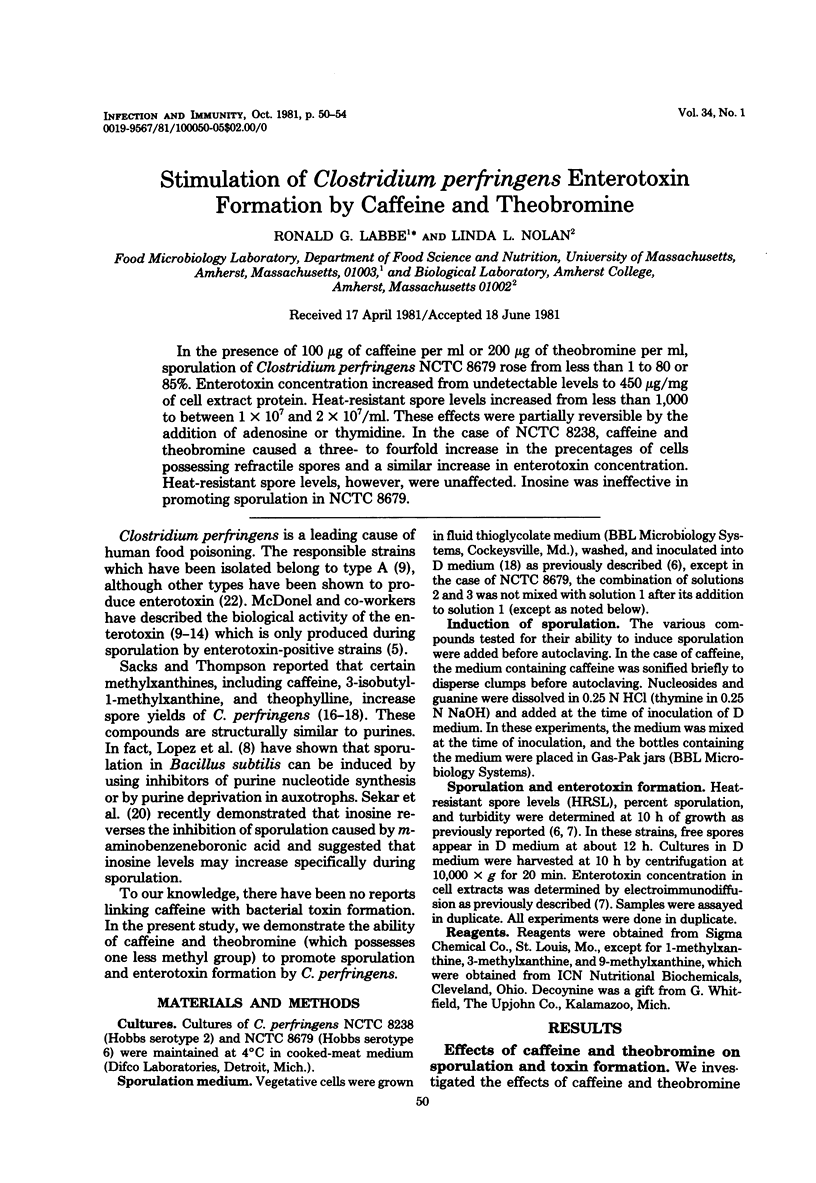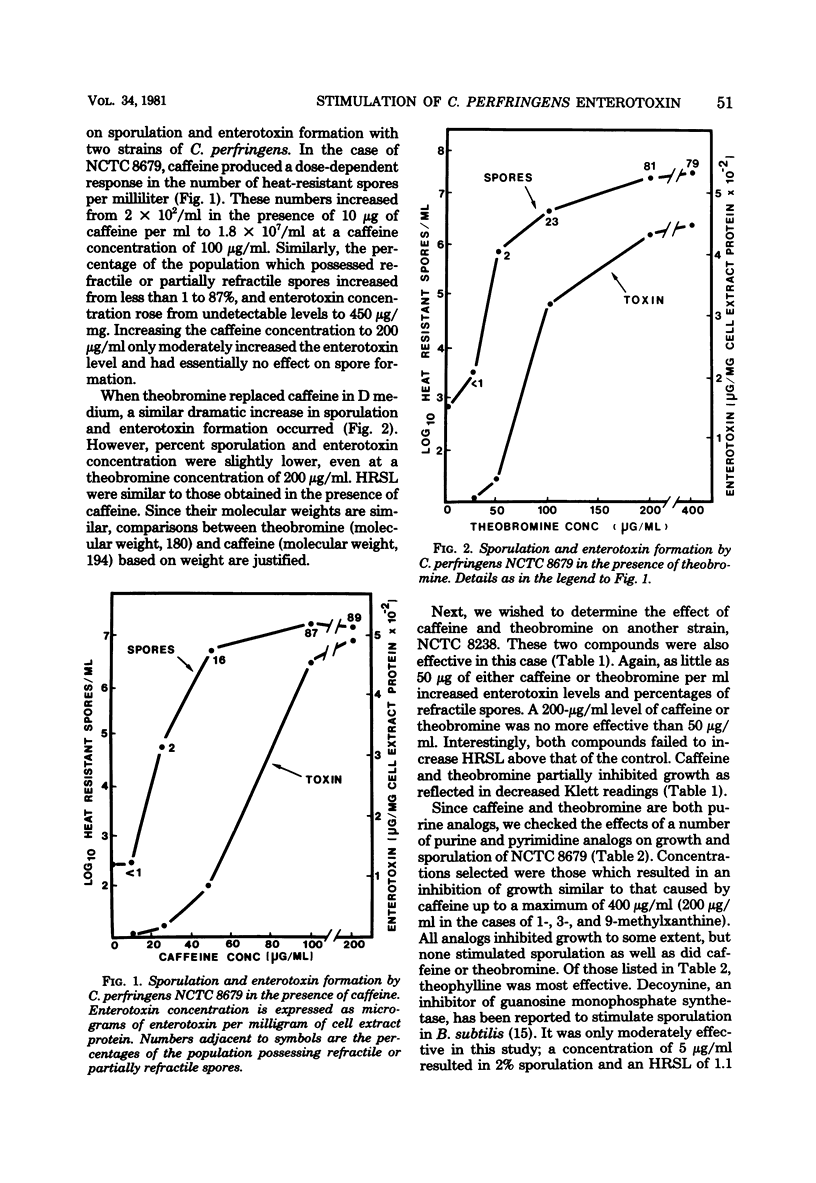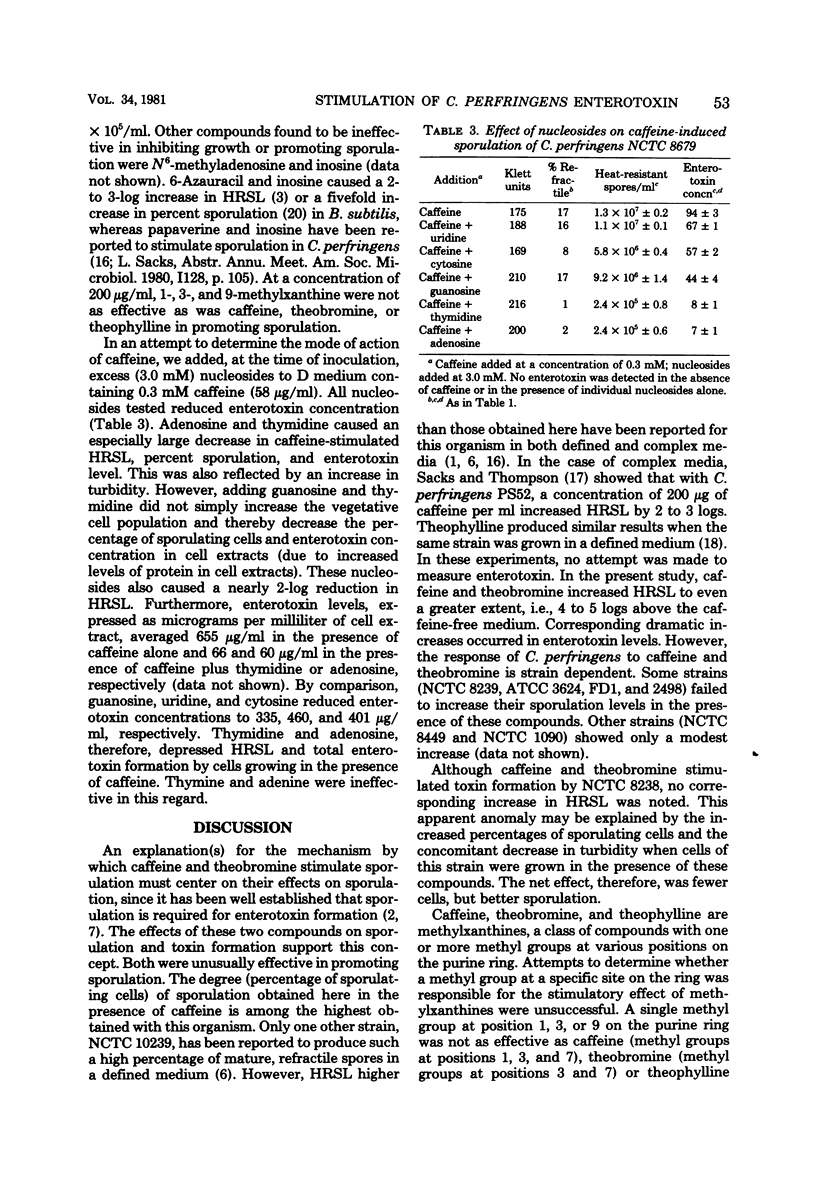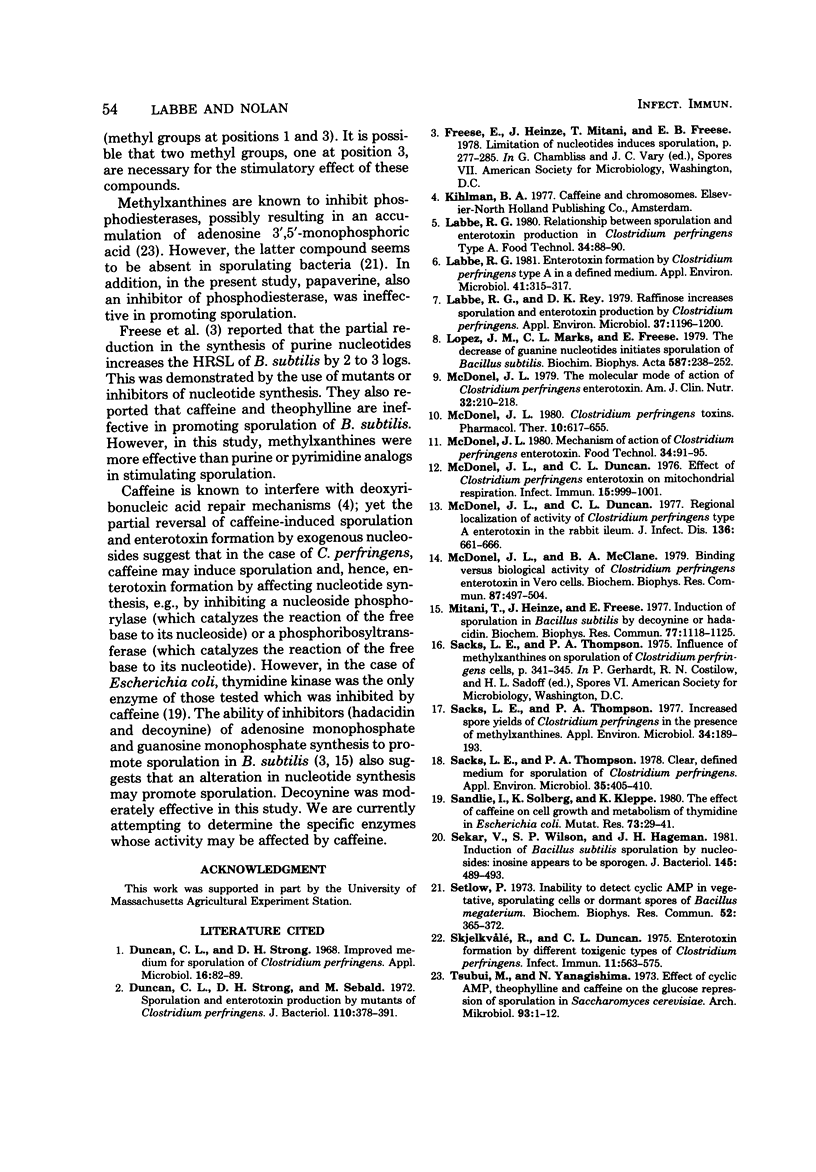Abstract
In the presence of 100 micrograms of caffeine per ml or 200 micrograms of theobromine per ml, sporulation of Clostridium perfringens NCTC 8679 rose from less than 1 to 80 or 85%. Enterotoxin concentration increased from undetectable levels to 450 micrograms/mg of cell extract protein. Heat-resistant spore levels increased from less than 1,000 to between 1 X 10(7) and 2 X 10(7)/ml. These effects were partially reversible by the addition of adenosine or thymidine. In the case of NCTC 8238, caffeine and theobromine caused a three- to fourfold increase in the percentages of cells possessing refractile spores and a similar increase in enterotoxin concentration. Heat-resistant spore levels, however, were unaffected. Inosine was ineffective in promoting sporulation in NCTC 8679.
Full text
PDF




Selected References
These references are in PubMed. This may not be the complete list of references from this article.
- Duncan C. L., Strong D. H. Improved medium for sporulation of Clostridium perfringens. Appl Microbiol. 1968 Jan;16(1):82–89. doi: 10.1128/am.16.1.82-89.1968. [DOI] [PMC free article] [PubMed] [Google Scholar]
- Duncan C. L., Strong D. H., Sebald M. Sporulation and enterotoxin production by mutants of Clostridium perfringens. J Bacteriol. 1972 Apr;110(1):378–391. doi: 10.1128/jb.110.1.378-391.1972. [DOI] [PMC free article] [PubMed] [Google Scholar]
- Labbe R. G. Enterotoxin formation by Clostridium perfringens type A in a defined medium. Appl Environ Microbiol. 1981 Jan;41(1):315–317. doi: 10.1128/aem.41.1.315-317.1981. [DOI] [PMC free article] [PubMed] [Google Scholar]
- Labbe R. G., Rey D. K. Raffinose increases sporulation and enterotoxin production by Clostridium perfringens type A. Appl Environ Microbiol. 1979 Jun;37(6):1196–1200. doi: 10.1128/aem.37.6.1196-1200.1979. [DOI] [PMC free article] [PubMed] [Google Scholar]
- Lopez J. M., Marks C. L., Freese E. The decrease of guanine nucleotides initiates sporulation of Bacillus subtilis. Biochim Biophys Acta. 1979 Oct 4;587(2):238–252. doi: 10.1016/0304-4165(79)90357-x. [DOI] [PubMed] [Google Scholar]
- McDonel J. L. Clostridium perfringens toxins (type A, B, C, D, E). Pharmacol Ther. 1980;10(3):617–655. doi: 10.1016/0163-7258(80)90031-5. [DOI] [PubMed] [Google Scholar]
- McDonel J. L., Duncan C. L. Effect of Clostridium perfrongens enterotoxin in mitochondrial respiration. Infect Immun. 1977 Mar;15(3):999–1001. doi: 10.1128/iai.15.3.999-1001.1977. [DOI] [PMC free article] [PubMed] [Google Scholar]
- McDonel J. L., Duncan C. L. Regional localization of activity of Clostridium perfringens type A enterotoxin in the rabbit ileum, jejunum, and duodenum. J Infect Dis. 1977 Nov;136(5):661–666. doi: 10.1093/infdis/136.5.661. [DOI] [PubMed] [Google Scholar]
- McDonel J. L., McClane B. A. Binding versus biological activity of Clostridium perfringens enterotoxin in Vero cells. Biochem Biophys Res Commun. 1979 Mar 30;87(2):497–504. doi: 10.1016/0006-291x(79)91823-0. [DOI] [PubMed] [Google Scholar]
- McDonel J. L. The molecular mode of action of Clostridium perfringens enterotoxin. Am J Clin Nutr. 1979 Jan;32(1):210–218. doi: 10.1093/ajcn/32.1.210. [DOI] [PubMed] [Google Scholar]
- Mitani T., Heinze J. E., Freese E. Induction of sporulation in Bacillus subtilis by decoyinine or hadacidin. Biochem Biophys Res Commun. 1977 Aug 8;77(3):1118–1125. doi: 10.1016/s0006-291x(77)80094-6. [DOI] [PubMed] [Google Scholar]
- Sacks L. E., Thompson P. A. Clear, defined medium for the sporulation of Clostridium perfringens. Appl Environ Microbiol. 1978 Feb;35(2):405–410. doi: 10.1128/aem.35.2.405-410.1978. [DOI] [PMC free article] [PubMed] [Google Scholar]
- Sacks L. E., Thompson P. A. Increased spore yields of Clostridium perfringens in the presence of methylxanthines. Appl Environ Microbiol. 1977 Aug;34(2):189–193. doi: 10.1128/aem.34.2.189-193.1977. [DOI] [PMC free article] [PubMed] [Google Scholar]
- Sandlie I., Solberg K., Kleppe K. The effect of caffeine on cell growth and metabolism of thymidine in Escherichia coli. Mutat Res. 1980 Nov;73(1):29–41. doi: 10.1016/0027-5107(80)90133-5. [DOI] [PubMed] [Google Scholar]
- Sekar V., Wilson S. P., Hageman J. H. Induction of Bacillus subtilis sporulation by nucleosides: inosine appears to be sporogen. J Bacteriol. 1981 Jan;145(1):489–493. doi: 10.1128/jb.145.1.489-493.1981. [DOI] [PMC free article] [PubMed] [Google Scholar]
- Setlow P. Inability of detect cyclic AMP in vegetative or sporulating cells or dormant spores of Bacillus megaterium. Biochem Biophys Res Commun. 1973 May 15;52(2):365–372. doi: 10.1016/0006-291x(73)90720-1. [DOI] [PubMed] [Google Scholar]
- Skjelkvålé R., Duncan C. L. Enterotoxin formation by different toxigenic types of Clostridium perfringens. Infect Immun. 1975 Mar;11(3):563–575. doi: 10.1128/iai.11.3.563-575.1975. [DOI] [PMC free article] [PubMed] [Google Scholar]
- Tsuboi M., Yanagishima N. Effect of cyclic AMP, theophylline and caffeine on the glucose repression of sporulation in Saccharomyces cerevisiae. Arch Mikrobiol. 1973 Oct 4;93(1):1–12. doi: 10.1007/BF00666076. [DOI] [PubMed] [Google Scholar]


